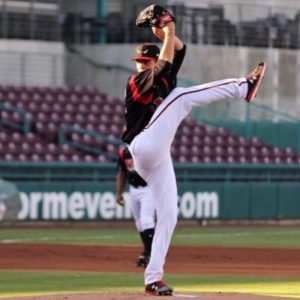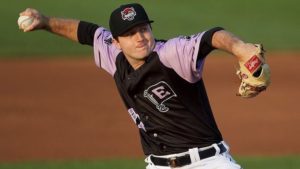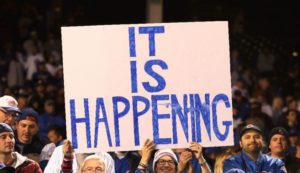
Ann Arbor Landlubber
Graduates: Chris Paddack (SP), Austin Riley (3B), Danny Jansen (C), Christin Stewart (OF), Shed Long (2B), Richie Martin (SS), Austin Voth (SP)
Risers: Dylan Carlson (OF), Matt Manning (SP)
Top Prospects: 1. Dylan Carlson (OF), 2. Matt Manning (SP), 3. Vidal Brujan (2B), 4. Tyler Freeman (SS), 5. Dane Dunning (SP), 6. Daniel Johnson (OF), 7. Quinn Priester (SP), 8. Christian Javier (SP), 9. Corbin Martin (SP), 10. Gilbert Celestino (OF), 11. Alejandro Kirk (C)
Ann Arbor slides down the rankings slightly, but with the quality number of graduates the Landlubbers have that’s not surprising. Led by starters Chris Paddack and Austin Voth, catcher Danny Jansen, and OF/3B Austin Riley, Ann Arbor welcomed seven rookies to their major league club this spring. Paddack pairs a plus-plus changeup with a 92-95 mph fastball and pinpoint control to destabilize any hitters timing while Voth relies on his four pitch mix and the willingness to use any pitch in any situation to stymie hitters. The pair combined for 180+ innings of 3.30 ERA / 0.99 WHIP pitching; ace level by any measure. Jansen had a rough go of it at the plate, but he continued to show superior receiving and game calling skills behind it. Riley tailed off after a fast start, but 18 home runs in half a season showed his power potential. He will need to reign in his 36% K rate to fully realize his offensive potential. On the farm, one of the fastest risers not only in the Ann Arbor system but in the minors overall was outfielder Dylan Carlson. Drafted out of high school on pure athletic tools and baseball instincts, Carlson has had to build his baseball skill set. Preternatural strike zone judgement and pitch recognition as a teen has fueled his development and he now stands one step from the majors with a plus hit tool, patience, power, speed, and instincts that allow all his skills to play a step above his physical talents. 20/20 seasons and plus defense at any one of the outfield positions should be in the near future. Starter Matt Manning is another high school pick who has taken some time to develop. After being a two sport star in high school and receiving a scholarship from Loyola Marymount to play both baseball and basketball, Manning only begun focusing on pitching once he signed. His ascent has been steady and his progression has rewarded the Landlubbers talent evaluators who saw the raw makings of a power #2 arm. Manning has refined his mechanics to add velocity to his fastball and he now sits easily in the mid-90’s. His 6’6” frame gives him excellent extension and allows the fastball to look even quicker than that. Manning pairs a plus hammer curve with his power and has the control of the pitch to locate it in or out of the zone. The final piece will be the impact of his developing changeup, which has shown at least above-average potential. Second baseman Vidal Brujan has also jumped up the rankings, proving his bat-to-ball skills and plus-plus speed as he has continued to rise through the minors. Brujan will be reliant on his on base skills and speed as he has very little power to add. He is an instinctive fielder who should be well above average at the keystone. There is plenty of depth at the lower levels that could allow the Landlubber system to rise in short order and the development of players like Paddack, Carlson, Manning and Brujan give reason for optimism in Ann Arbor.
Data City Cache Hogs
Graduates: Fernando Tatis Jr. (SS), Zac Gallen (SP), Garrett Hampson (2B), Corbin Burnes (SP)
Risers: Cristian Pache (OF)
Top Prospects: 1. Cristian Pache (OF), 2. Alex Kirilloff (OF), 3. Nolan Jones (3B), 4. Greg Jones (SS), 5. Austin Hays (OF), 6. Ezequiel Duran (2B), 7. Jake Fraley (OF), 8. William Contreras (C), 9. Esteury Ruiz (2B), 10. Colton Welker (3B), 11. Bryan Abreu (SP)
Data City slips in this years rankings, but that does not mean the system is bare. To begin with, the Hogs welcomed shortstop Fernando Tatis Jr. to the big club and were it not for a hamstring injury that cost him a month and a season ending stress fracture in August, Tatis could have posted a 30/30 season and a legitimate MVP run. He plays with maturity and discipline on both sides of the ball, but underlying everything he does is an exuberance and energy that is infectious. In the middle of the lineup and in the middle of the diamond, Data City looks to have found its cornerstone in Tatis. Also graduating with honors was starter Zac Gallen. Largely unheralded as a prospect until he made some changes in AAA, Gallen nonetheless showed near ace level production. His fastball is not blazing, sitting in the low 90’s, but he has high spin rate to the pitch and misses plenty of bats with the movement of the pitch. His best pitch is his changeup, which has 10-12 miles of separation and excellent fade. The most effective change Gallen made was the development and use of a slider/cutter. The pitch features dramatic late break on two planes and gives Gallen a third above-average pitch. The top of the farm is highlighted by two near ready outfielders, Cristian Pache and Alex Kirilloff. Kirilloff is the better hitter, with a plus hit tool and power to go with a patient, disciplined approach. Defensively, Kirilloff has the arm strength to play rightfield, but he probably won’t be any better than average in the field overall. Pache on the other hand is Gold Glove caliber in centerfield now. His speed, instincts, reads, and routes are all outstanding and give him remarkable range in every direction. Pache pairs that range with a cannon of an arm that will make every runner wary. Offensively, Pache makes a ton of hard contact that sprays line drives to all fields and is beginning to show over the fence power, but he will need to continue improving his approach, patience and discipline. The Hogs have a pair of Jones’ who could man the left side of their infield in the future in third baseman Nolan Jones and shortstop Greg Jones. Nolan is a patient, disciplined hitter who looks to drive his pitch. This approach results in a lot of walks, a lot of strikeouts, and a lot of power. He may not hit for a high average, but high on base averages and possible 30 HR power will be Jones’ calling card. He has the arm strength for the hot corner, but after focusing more on hockey until late in high school, Jones is still learning the footwork and actions at third. Greg is an ultra-athletic fast twitch player who possesses enviable bat speed and foot speed. He controls the zone well but he needs to learn to be a bit more patient in hunting his pitch and accepting walks. Once on base he wreaks havoc with his 70 grade speed and he already steals base hits on grounders with his aggressiveness. He has the athleticism and arm strength to play short at the major league level, but he does have work to do on the nuances of the position. There is additional quality depth in outfielders Austin Hays and Jake Fraley, second baseman Ezequiel Duran and catcher William Contreras, but the system is weak at present on the pitching side.
Scurvy Dogs
Graduates: Keston Hiura (2B), Kolby Allard (SP), Matt Thaiss (1B)
Risers: George Kirby (SP)
Top Prospects: 1. Luis Robert (OF), 2. George Kirby (SP), 3. Miguel Vargas (3B), 4. Adrian Morejon (SP), 5. Diego Cartaya (C), 6. DJ Peters (OF), 7. Bayron Lora (OF), 8. Zack Collins (C), 9. Yainer Diaz (C), 10. Anderson Espinoza (SP)
Graduate Keston Hiura shot up through the system in less than two seasons and did not disappoint once he arrived. A .300 hitter with developing power, Hiura put up numbers in his half season that placed him among the top 3 second basemen in baseball offensively. He still needs to iron out his defense though, as he committed more errors than any other second baseman in baseball. Next to crack the majors for Scurvy will be Luis Robert. The Cuban outfielder may be the most gifted athlete in the minor leagues, rating above average or better in foot speed, arm strength, bat speed, and raw power. Hampered over his first two seasons by nagging injury, Robert broke out in 2019, posting the first .300 average, 30 steal, 30 HR season in the minors since 1961. He will need to refine his defense and base running to fully utilize his speed, and learn to be more selective at the plate once pitchers stop challenging him, but there isn’t a tool Robert doesn’t have and he could mature into a top 5 player in baseball. 2019 draftee George Kirby doesn’t light up radar guns, sitting low 90’s with his fastball, but he has tremendous movement and command of the pitch which allows it to play up even without the power. Kirby also has three average or better secondary offerings, led by his plus change up. He throws two breaking pitches, with his curve grading slightly better than his slider, but both pitches illicit swing and miss from batters. Kirby is a cerebral pitcher, already adept at mixing his pitches and setting hitters up. He forces batters to hit his pitch and while he may not be an ace level arm, his floor is very high and he should be a very effective #3 once he matures. The big arms in the system belong to Adrian Morejon and Anderson Espinoza. Unfortunately, Espinoza can’t stay healthy and Morejon took a step back last season so both have a lot to prove before they begin to realize some of their early potential. Third baseman Miguel Vargas possesses some of the best bat-to-ball skills in the system and has been pushed hard because of it. He has responded too, not only hitting well at every level, but showing the patience and discipline to hit his pitch and not the pitchers pitch. Power is developing and at 20 years old there is still physical maturity to realize. Defense is a concern with Vargas, but he has worked hard to improve at the hot corner and Scurvy will give him every opportunity to remain there. First base is the only option for the slow footed Vargas. Catcher is the position of depth in the system, led by teenager Diego Cartaya who has a well rounded game both at the plate and behind it. Zack Collins is just a step from the majors and is very highly rated defensively, as is Jake Rogers. Rogers however needs to prove his offensive game to stick. For raw power, there are few in baseball who can match DJ Peters. The athletic outfielder has 70 grade power and hits home runs that make crowds ooh and aah, but he has severe swing and miss tendencies and there are obvious questions whether he will ever hit enough to reach his power in game.
Windy City Rattlers
Graduates: Vladimir Guerrero Jr. (3B), Francisco Mejia (C), Aristides Aquino (OF), Kyle Wright (SP), Justus Sheffield (SP)
Risers: Drew Waters (OF)
Top Prospects: 1. CJ Abrams (SS), 2. Drew Waters (OF), 3. Hunter Greene (SP), 4. Shane Baz (SP), 5. Robert Puason (SS), 6. Ethan Small (SP), 7. Parker Meadows (OF), 8. Brennan Malone (SP), 9. Jhailyn Ortiz (1B), 10. Osiel Rodriguez (SP)
Vlad Jr. is the crown jewel of the Windy City system, even if some see his rookie campaign as a disappointment. It took some time to adjust to the majors, as it does for all 20-year olds, but even through the adjustment, Guerrero’s electric hitting ability showed through. Francisco Mejia once again showed his advanced defensive ability while holding his own at the plate and Aristides Aquino burst on to the scene like no other rookie ever has. Taking extra time to make the bigs due to his hyper aggressive batting approach and swing and miss tendencies his 19 home runs in what amounted to about a third of a season shows what he is capable of offensively. On the farm, Windy City is led by 2019 1st rounder CJ Abrams. Abrams separates himself with his blend of elite speed, athleticism and natural hitting ability and after a spectacular showing last season, Abrams could be on the fast track. While he will always produce high doubles and triples numbers due to his line drive stroke and 80 grade speed, his home run pop is still a question. The predicted range swings from below average to average to some who even believe he can exceed the expectations and produce above-average power at the major league level. No matter what the outcome on that front, Abrams already shows the makeup of an impact lead off threat. Defensively, his position is still in question, due more to his athleticism and ability to play multiple positions than his current abilities at short. He has all the tools to be an above average shortstop, but his tools and ultimate skills may fit better elsewhere in the long run. One of the fastest risers in the minors is outfielder Drew Waters. Drafted on pure athleticism out of high school, Waters had plenty of work to do on his approach, stride and swing as a hitter and once those changes became comfortable, he took off last season. Producing line drives to all fields and using his plus speed, Waters puts constant pressure on the defense. His base stealing is still a little raw, but his speed, instincts and arm strength translate into major league ready defense now. He could easily handle centerfield long term, but his arm strength may play better in right field. Starter Hunter Greene’s rehab from Tommy John surgery is reportedly going very well with a scheduled return to the mound sometime during the 2020 season. Greene brings elite power as one of just a handful of high schoolers to ever produce triple digits with his fastball. The fastball can flatten out when he elevates it, but when he keeps it down in the zone, the 97-102 mph pitch is near impossible to hit. Both his secondary offerings are rudimentary at present, with his slider flashing plus and his changeup showing promise. His poise, maturity and pitchability are routinely lauded by analysts. International signee Robert Puason is another high end athlete with five tool talent in the Windy City system. Additional pitching depth comes from Shane Baz, Ethan Small, Brennan Malone and Osiel Rodriguez and don’t sleep on outfielder Parker Meadows who has a similar skill set to his older brother, All-Star Austin.



